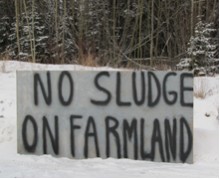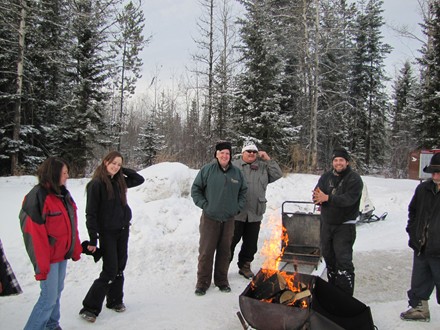Neighbors Occupy Road, Blockade Sludge Trucks
Recently, a group of farmers and neighbors in Salmon Valley, near Prince George, British Columbia, successfully blockaded Wright Creek Road and turned back a truck full of sewage sludge headed for a 117 acre parcel of farm land contracted as a dump site by the City of Prince George. One neighbor brought a snowmobile towing a portable fire pit on a sled so that they were able to keep warm while they blocked the road. As of this writing, the trucks have not returned.
Dumping Sludge on Farmland
 Andy Angele's sign on Wright Creek Road (Source: 250 News)The Center for Media and Democracy's Food Rights Network (FRN) spoke with Andreas Angele, whose land adjoins the contracted land at Arnette Ranch on Wright Creek Road. He gardens and grows hay for horses on his land. He says he first heard about the plan to dump processed human and industrial waste near his property in May, from a neighbor. (The private company that drafted the sludge application plan for the City of Prince George, Sylvis, claims it has been in touch with Angele since February). He says that although the City of Prince George application indicated that all neighbors within one kilometer would be notified in advance, that didn't happen. One of his neighbors received notification at work, and he and two others received none.
Andy Angele's sign on Wright Creek Road (Source: 250 News)The Center for Media and Democracy's Food Rights Network (FRN) spoke with Andreas Angele, whose land adjoins the contracted land at Arnette Ranch on Wright Creek Road. He gardens and grows hay for horses on his land. He says he first heard about the plan to dump processed human and industrial waste near his property in May, from a neighbor. (The private company that drafted the sludge application plan for the City of Prince George, Sylvis, claims it has been in touch with Angele since February). He says that although the City of Prince George application indicated that all neighbors within one kilometer would be notified in advance, that didn't happen. One of his neighbors received notification at work, and he and two others received none.
Angele and others in the area circulated a petition this summer and collected 1,000 signatures of area residents opposed to the dumping of toxic sludge on farmland.
What's at Risk
Angele told FRN, "This is quite a water resource-rich area, with six springs within 600 meters of the property where the sludge would be spread" and a spring near the center of that land.
Other concerns he listed in an email to local officials on Sunday included the high water table in the area, the slope of the land towards the spring as well as a local creek, copper levels in the sewage sludge that exceed allowed limits, the presence of triclocarbon and other endocrine disruptors in the sludge to be dumped, and the presence of highly toxic PCBs.
City of Prince George Spins the Sludge
In an interview with FRN, City of Prince George Superintendent of Operations Bill Gaal responded to citizens' allegations:
In British Columbia, biosolids use is regulated, and we follow those regulations. Before being applied to land, an application plan is created by a professional (in this case, John Lavrey of Sylvis[, a Canadian environmental consulting firm]). Through that process we're ensured that all criteria under Organic Management Recycling Regulations [(OMRR)] are met. We have utmost confidence that we will not be violating those regulations or creating problems to surrounding farmland or in fact the land where we will be applying the biosolids.
"Biosolids" is the Orwellian PR euphemism for treated human and industrial waste; i.e., toxic sewage sludge. The name was created and chosen in a PR contest by the United States lobby association for the sewage industry, the Water Environment Federation (WEF), in 1991.
Sewage sludge has also been shown to contain flame retardants, endocrine disruptors, pharmaceutical residues, phthalates, industrial solvents, resistant pathogens, and perfluorinated compounds, which can bioaccumulate in plants grown in sludge-contaminated soil.
Gaal referred FRN to John Lavrey, Senior Environmental Scientist at Sylvis, who completed the land application plan for the City of Prince George.
Lavrey told FRN, "This activism does come at the end of a long consultation with the parties involved. ... We've been in discussion with the community in general and one of the people key in the blockades since February (Andy Angele) ... We had an open house meeting for the broader community at which the group was welcome to ask further questions." He added that this community consultation is not required under OMRR (Organic Matter Recycling Regulation).
When asked if Sylvis had tested the "Class B Biosolids" -- defined and regulated by each province in Canada -- for dioxins and furans, flame retardants, pharmaceutical residues, phthalates and resistant pathogens, Sylvis responded by email:
The City of Prince George undertook an exploratory sampling of specified components from all of the above microconstituent families in 2010. ... All microconstituents were compared with relevant guideline requirements for soil and water quality, and found to meet the requirements of those guidelines following application to the soil. ... The City does not undertake regular sampling for the above mentioned microconstituents.
"Microconstituents" are defined by WEF (pdf) -- the same sludge trade group that came up with the euphemism "biosolids" -- as "natural and manmade substances, including elements and inorganic and organic chemicals, detected within water and the environment for which continued assessment of the potential impact on human health and the environment is a prudent course of action." No major cause for alarm, right?
The term is misleading because it emphasizes the size of the particles of the toxic contaminants without addressing the total quantity of the contaminants or their individual or combined toxicity.
Sylvis also wrote the "best management practices" for sludge application to land under OMRR guidelines in 2008.
Despite this, the approved land application plan for Arnette Ranch, obtained by FRN, allows for copper levels above OMRR guidelines for Class A or Class B "biosolids." It also provides for a sludge stockpile surrounded by a berm "to mitigate leachate movement," suggesting that "the intercepted water collected within the ditch on the outside of the berm will drain away naturally" -- right into groundwater. Under the plan, "no post-application sampling of groundwater is required nor proposed."
Turning the Truck Around
 Salmon Valley Sludge Protesters Keep Warm (Source: 250 News)Despite the public outcry, Angele received an email from the city informing him that they would start hauling sludge to the property on November 28. So he made a sign and went out to the highway at a point they would pass. Nothing happened for two weeks, more neighbors joined him, and then one Friday afternoon, the truck showed up and they created the blockade.
Salmon Valley Sludge Protesters Keep Warm (Source: 250 News)Despite the public outcry, Angele received an email from the city informing him that they would start hauling sludge to the property on November 28. So he made a sign and went out to the highway at a point they would pass. Nothing happened for two weeks, more neighbors joined him, and then one Friday afternoon, the truck showed up and they created the blockade.
The truck turned around and returned to the City of Prince George later that afternoon.
According to local reports, the police and the farmer with the sludge spreading contract are "exploring their options," including "an application for a court injunction."
Angele responded, "In order to protect the environment around me and the water resources around me, I'll have to do whatever I can to stop it. I'll block the road again -- and other neighbors are also willing -- even if an injunction comes."
| Attachment | Size |
|---|---|
| Salmon Valley Sludge Petition.pdf | 88.67 KB |





Comments
Concerns about portrayal of sewage sludge
Rebekah,
I am a student at the Univ. of Washington in Seattle, and have been hearing a lot about sewage sludge lately. I have no research or financial interests in sewage sludge. I am merely a concerned citizen that wants to hear the full story about sewage sludge. While I think it is important to look into this form of fertilizer and assure that it is safe, I also think that it is important for people like you (that provide information to the public about sewage sludge) to take a deep and objective look into why sludge might be dangerous and how it compares with alternatives (a cost and benefit analysis might be a nice method to start with). Before CMD jumps on the progressive bandwagon opposing this substance, it is important to provide information about the specific risks of using sludge as fertilizer. There are clear benefits to closing the waste loop and returning human waste into the ecosystem, so long as it is safe.
While I agree that some of the chemicals found in sludge are harmful at certain doses, it is important to include in the discussion information about background levels of those contaminants, and the levels of contaminants found in alternative forms of fertilization. I am concerned that backlash against the use of recycled human waste or sludge will create more demand for synthetic fertilizers that create financial dependency for farmers, decrease the long-term productivity of land, increase incentives for massive monoculture farming techniques, and support an energy industry that CMD and the public have well-supported concerns about. If sewage sludge is a more harmful alternative, then I agree that it should not be used. However, I have doubts that one can draw that conclusion from the information currently presented in CMD articles.
As a representative of CMD, please provide some information to back up the apparently foregone conclusion that sewage sludge is worse for the environment than other alternatives (conventional, organic, or otherwise). The mere presence of some undisclosed amount of toxic, persistent chemicals should not suffice for you or an educated public. You could do a lot of good by providing an objective, dispassionate assessment of sewage sludge, instead of simply fomenting the distrust and half-understanding of this fertilizer. I believe that CMD would agree that reporting should not be about reinforcing your own viewpoint (or the viewpoint of your organization), but rather providing your audience with a better understanding of the issues that affect their lives. I don't need a rehash of the controversy - help me understand the issue.
Patrick Bridegam